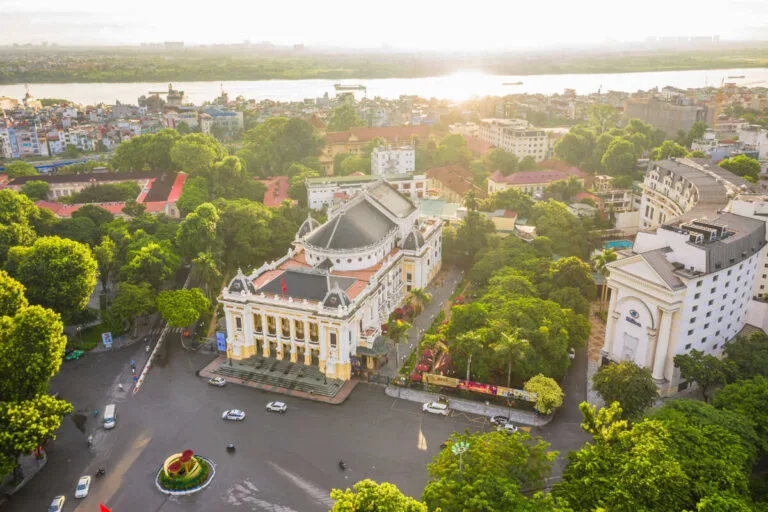2024 is the year that marks Asia’s tourism comeback.
All around the Orient, numerous destinations are recording record surges in the number of foreign visitors, fueled by improved connectivity, tourist-friendly policies, and even reduced bureaucracy in the issuing of visas.
A sprawling metropolis with a lot going for it on the culture front, Vietnam’s Hanoi is one of them, predicting a whopping 5 million international tourist arrivals this year according to TTXVN, the official state-run news agency Vietnam.
Hanoi will now be facing off Tokyo, Singapore and Bangkok for the title of Asia’s leading city break.
Visitors from all over the world have been flocking in here lately, and Westerners in particular, and it’s time we looked into some of the reasons why:
A One-Of-A-Kind Capital City

Hanoi is the capital of Vietnam, a country in Southeast Asia best known for its tropical climate, long, narrow coastline lapped by turquoise seas, breathtaking nature, and historic towns dating back several centuries.
It is one of the fastest-growing cities in Asia, with a population that already sits well over 8 million, and other than hosting government headquarters and being an economic powerhouse for Vietnam’s underdeveloped North, it is a world-class cultural hotspot.

There’s no shortage of historical sites across Vietnamese cities, from the French architecture in Ho Chi Minh City (formerly Saigon), in the South, to the walled city of Hue and fairytale, yellow-washed Hoi An in the Central provinces, but Hanoi concentrates the highest number of them.
It Is Home To An Imperial City
It is distinct for being architecturally eclectic, with native Indochinese, colonial landmarks, brutalist apartment blocks, typical of socialist states, and modernism making for a unique cityscape, and however oppressive the urbanism may be, there’s always a lake-dotted city park nearby to escape to.

Millions of tourists visit Hanoi to stand before the gates of the Imperial Citadel of Thăng Long, a UNESCO-listed 11th century fort, sip Vietnamese iced coffee as they watch trains rattle along impossibly-narrow streets lined by modest houses, admire the Gothic, European St. Joseph’s Cathedral, and sample food from local markets in the Old Quarter.
Hanoi is also famous for housing the Ho Chi Minh Mausoleum, where the Vietnamese revolutionary, who played a key role in the reunification of both Vietnams is resting, Hoàn Kiếm Lake, with the iconic Turtle Tower on an islet in its middle, and the French-built Opera House.
What truly makes Hanoi, however, is the people: ask any American or European who has been to the city, and they’ll tell you their interactions with the humble, kind-hearted locals were the absolute highlight of the trip.
Friendly Locals And A Casual Social Scene
You’d be surprised at how welcoming Hanoi natives are, even if they’re older and have a limited knowledge of English, and regardless of living in a cosmopolitan hub where, in theory, hospitality wouldn’t be as strong a value as it is in the countryside.

Hanoi’s youthful atmosphere is an equally big draw for foreign tourists, who are not coming in droves for the nightlife, necessarily—there are bars and nightclubs, for sure, but this is no Bangkok—but for the thriving social scene, café culture, and lively night markets.
Incredible Food
Other than the architecture and friendliness towards guests, food is as important a cultural trait in Hanoi, and whether you’re sampling your way through a street market, or gorging on North Vietnamese food with a high-end twist at a luxury restaurant, your taste buds are in for a thrill!
We’re talking a literal food fest of warm, freshly-made pho soups, delicious prawn-stuffed rice paper rolls, cao lau noodles and sweet potato-based stew miến, all of this without taking a hit to the wallet, because of course, there’s Hanoi’s shocking affordability.
Hanoi Is The Second Cheapest Tourist Destination In The World
It is the cheapest national capital in Southeast Asia, but according to research by British website Wethrift (check it out here), it’s beaten to the number one spot worldwide only by New Delhi in India.
According the the research, meals in curbside restaurants cost as cheap as $2, more elaborate, three-course dinners in fancy diners are $25-30, and the average price of hotels is $49.

If they’re being strictly economical, tourists can spend as little as $17 per day in Hanoi, when staying in youth hostels, eating street food, and opting for free tourist attractions, like the infamous ‘Train Street’, which was recently cordoned-off to prevent incidents and the manmade city lakes.
Usually, though, you should plan on spending $48 per day in Hanoi or a reasonable $334 for the whole week; for the odd high-end traveler, who’s keen on expensive dining and five-star hotels, it’s still a ‘negligible’ $143 daily, and just over a thousand bucks for a seven-day stay.
Daily costs will always vary greatly based on where you are staying and eating, as well as which activities you prioritize, so take these estimates with a grain of salt!
With its many temples, UNESCO World Heritage Sites, lush-green parks amid modern buildings, and Hanoi is one of the cheapest, most incredible cultural destinations this year.
Credit: Source link



